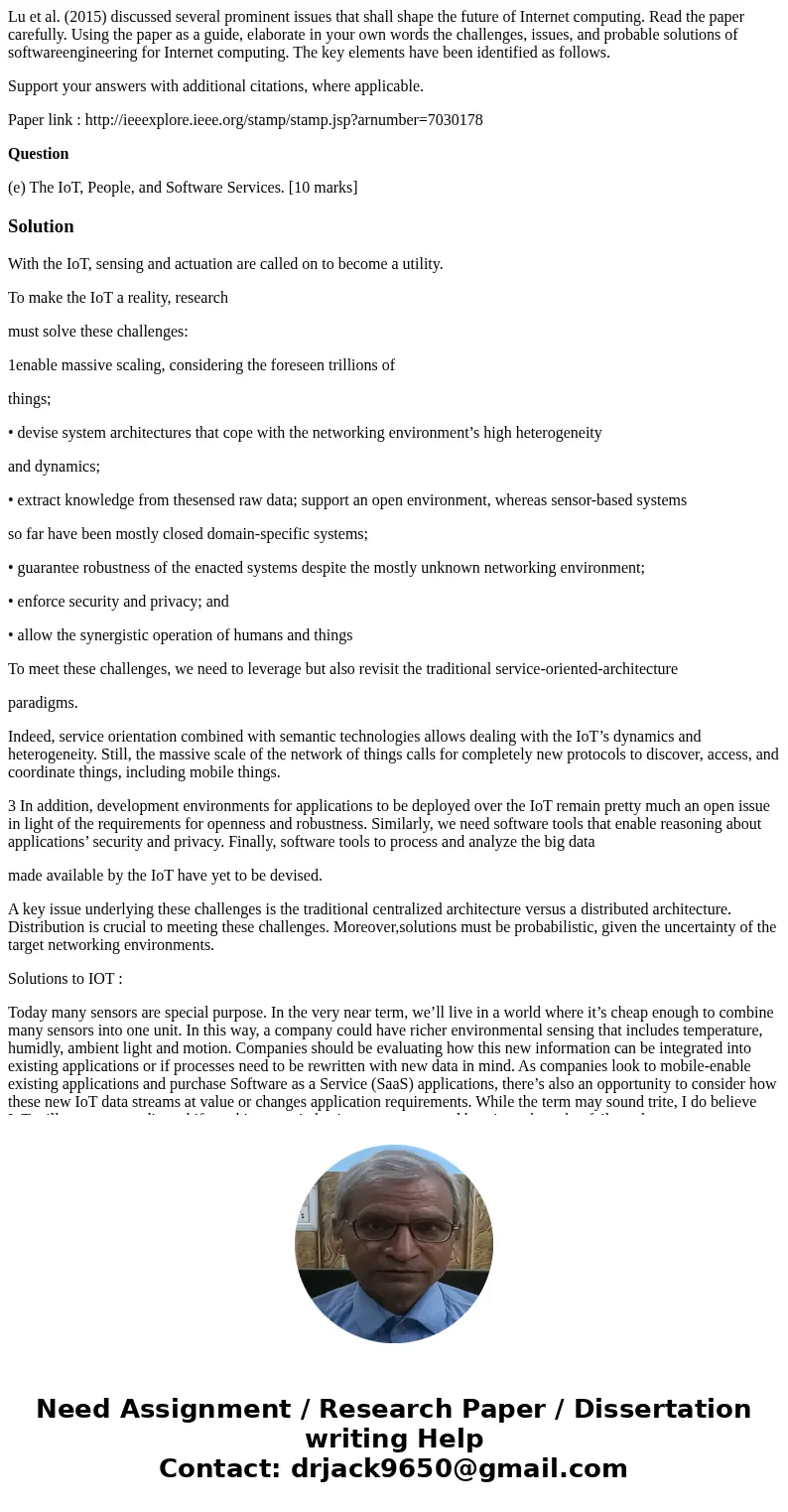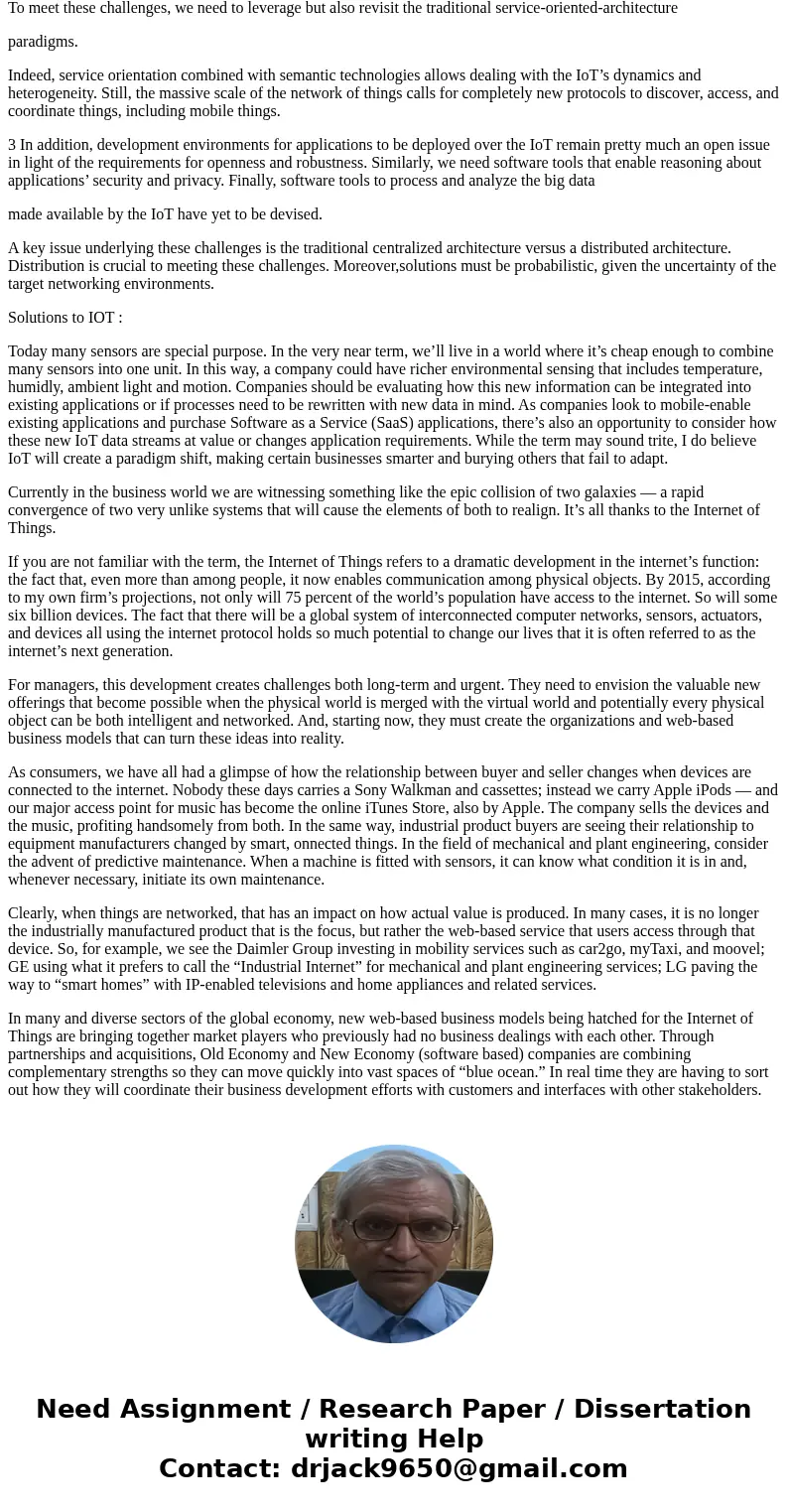Lu et al 2015 discussed several prominent issues that shall
Lu et al. (2015) discussed several prominent issues that shall shape the future of Internet computing. Read the paper carefully. Using the paper as a guide, elaborate in your own words the challenges, issues, and probable solutions of softwareengineering for Internet computing. The key elements have been identified as follows.
Support your answers with additional citations, where applicable.
Paper link : http://ieeexplore.ieee.org/stamp/stamp.jsp?arnumber=7030178
Question
(e) The IoT, People, and Software Services. [10 marks]
Solution
With the IoT, sensing and actuation are called on to become a utility.
To make the IoT a reality, research
must solve these challenges:
1enable massive scaling, considering the foreseen trillions of
things;
• devise system architectures that cope with the networking environment’s high heterogeneity
and dynamics;
• extract knowledge from thesensed raw data; support an open environment, whereas sensor-based systems
so far have been mostly closed domain-specific systems;
• guarantee robustness of the enacted systems despite the mostly unknown networking environment;
• enforce security and privacy; and
• allow the synergistic operation of humans and things
To meet these challenges, we need to leverage but also revisit the traditional service-oriented-architecture
paradigms.
Indeed, service orientation combined with semantic technologies allows dealing with the IoT’s dynamics and heterogeneity. Still, the massive scale of the network of things calls for completely new protocols to discover, access, and coordinate things, including mobile things.
3 In addition, development environments for applications to be deployed over the IoT remain pretty much an open issue in light of the requirements for openness and robustness. Similarly, we need software tools that enable reasoning about applications’ security and privacy. Finally, software tools to process and analyze the big data
made available by the IoT have yet to be devised.
A key issue underlying these challenges is the traditional centralized architecture versus a distributed architecture. Distribution is crucial to meeting these challenges. Moreover,solutions must be probabilistic, given the uncertainty of the target networking environments.
Solutions to IOT :
Today many sensors are special purpose. In the very near term, we’ll live in a world where it’s cheap enough to combine many sensors into one unit. In this way, a company could have richer environmental sensing that includes temperature, humidly, ambient light and motion. Companies should be evaluating how this new information can be integrated into existing applications or if processes need to be rewritten with new data in mind. As companies look to mobile-enable existing applications and purchase Software as a Service (SaaS) applications, there’s also an opportunity to consider how these new IoT data streams at value or changes application requirements. While the term may sound trite, I do believe IoT will create a paradigm shift, making certain businesses smarter and burying others that fail to adapt.
Currently in the business world we are witnessing something like the epic collision of two galaxies — a rapid convergence of two very unlike systems that will cause the elements of both to realign. It’s all thanks to the Internet of Things.
If you are not familiar with the term, the Internet of Things refers to a dramatic development in the internet’s function: the fact that, even more than among people, it now enables communication among physical objects. By 2015, according to my own firm’s projections, not only will 75 percent of the world’s population have access to the internet. So will some six billion devices. The fact that there will be a global system of interconnected computer networks, sensors, actuators, and devices all using the internet protocol holds so much potential to change our lives that it is often referred to as the internet’s next generation.
For managers, this development creates challenges both long-term and urgent. They need to envision the valuable new offerings that become possible when the physical world is merged with the virtual world and potentially every physical object can be both intelligent and networked. And, starting now, they must create the organizations and web-based business models that can turn these ideas into reality.
As consumers, we have all had a glimpse of how the relationship between buyer and seller changes when devices are connected to the internet. Nobody these days carries a Sony Walkman and cassettes; instead we carry Apple iPods — and our major access point for music has become the online iTunes Store, also by Apple. The company sells the devices and the music, profiting handsomely from both. In the same way, industrial product buyers are seeing their relationship to equipment manufacturers changed by smart, onnected things. In the field of mechanical and plant engineering, consider the advent of predictive maintenance. When a machine is fitted with sensors, it can know what condition it is in and, whenever necessary, initiate its own maintenance.
Clearly, when things are networked, that has an impact on how actual value is produced. In many cases, it is no longer the industrially manufactured product that is the focus, but rather the web-based service that users access through that device. So, for example, we see the Daimler Group investing in mobility services such as car2go, myTaxi, and moovel; GE using what it prefers to call the “Industrial Internet” for mechanical and plant engineering services; LG paving the way to “smart homes” with IP-enabled televisions and home appliances and related services.
In many and diverse sectors of the global economy, new web-based business models being hatched for the Internet of Things are bringing together market players who previously had no business dealings with each other. Through partnerships and acquisitions, Old Economy and New Economy (software based) companies are combining complementary strengths so they can move quickly into vast spaces of “blue ocean.” In real time they are having to sort out how they will coordinate their business development efforts with customers and interfaces with other stakeholders.


 Homework Sourse
Homework Sourse